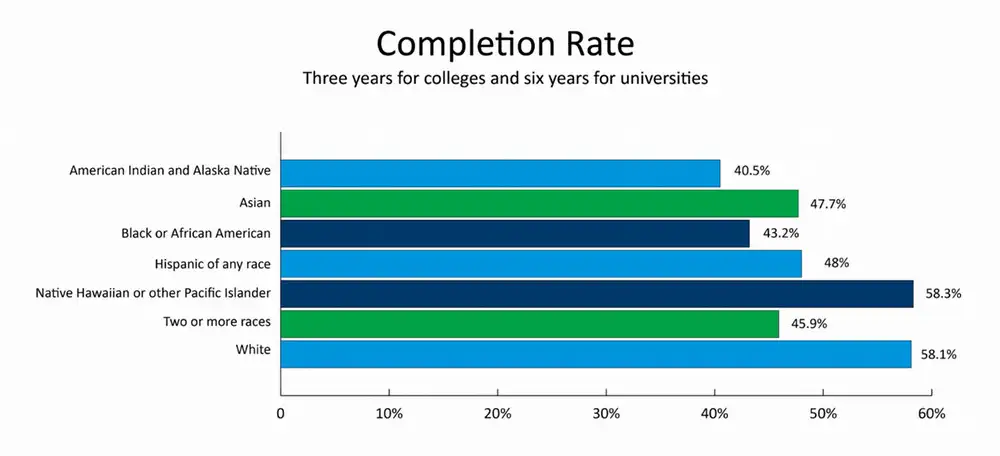Equity Scorecard: A Tool to Improve Equity

By Priyank Shah, Executive Director for the Center for Data Access and Analytics, Minnesota State
Tarrence Robertson, Project Director of Diversity, Equity and Inclusion, Minnesota State
August 15, 2022
In recent months, if you work at a Minnesota State college or university, there is a good chance that you and your colleagues have discussed matters of equity and Equity 2030. There’s also a good chance that some of the following questions have been raised: How do we improve equity? What is equity and what are equity gaps? How big are the gaps? What is our aim? Where do we start? How do we do this?
In 2019, Minnesota State introduced the bold goal of Equity 2030, which calls for addressing, narrowing, and eliminating equity gaps in our student outcomes. For many years, our system and campuses have sought to shed light on the equity gaps across our colleges and universities using data. Yet, we also know that we have not been able to turn the corner in seeing a sustained decrease in the degree and credential attainment rate gap between socio-demographic student populations, particularly for disadvantaged and marginalized groups. To address and better understand continued disparities, Minnesota State developed a tool called the Equity Scorecard. The Equity Scorecard is an equity analysis tool and resource developed by the Minnesota State Office of Equity and Inclusion in partnership with a systemwide workgroup of stakeholders and other Minnesota State colleagues.
For Minnesota State’s collective efforts to improve equity, it is important to have a holistic approach for understanding the multiple facets of equity and inclusion that matter for our colleges and universities. There is no single approach or measure for assessing equity across complex organizations. Serving the needs, interests, and success of our students and employees inherently requires understanding and engaging equity on several fronts. For this reason, the Equity Scorecard encompasses six interlinked key performance Indicators, which include:
- Student Success
- Compositional Diversity
- Employee Retention & Development
- Supplier Diversity
- Equity Strategy & Action (in development)
- Campus Climate (in development)
It is important that we acknowledge the fact that the Equity Scorecard is not going to provide all of the solutions to the complex inequities that exist today. Rather, the tool helps us understand the size and scope of inequities across our colleges, universities, and system. In doing so, we can begin to holistically think about how our colleges, universities, and system can work to support the success of our students and employees by narrowing disparities in their outcomes and experiences.
So what is the Equity Scorecard?
In short, the Equity Scorecard is a tool to highlight equity gaps and prod consideration of how our colleges and universities can improve equity and success for our stakeholders. It seeks to convey, in a readily digestible manner, a snapshot of disparities in the outcomes and experiences of students and employees by socio-demographic characteristics, including the Equity 2030 priority groups of race and ethnicity, Pell Grant status, and first-generation status.
It is important to note that the Equity Scorecard is not intended to be a detailed report or in-depth exhaustive analysis tool. Furthermore, this tool is not meant to serve as a “report card” or an end-all or be-all tool for assessing all facets of equity. It provides a high-level view of equities and inequities and has been designed to continue to evolve and meet the needs of our collective efforts toward realizing Equity 2030.
How does a campus make use of the Equity Scorecard?
Efforts to realize greater equity inherently requires our stakeholders and leaders to engage in meaningful consideration and discussion about how Minnesota State and the colleges and universities can strategically work to address equity gaps. As campuses begin using the Equity Scorecard tool, campuses should seek to:
- Share equity gap information with all stakeholders throughout campus in order to promote transparency, increase familiarity with, and awareness of, disparity patterns between groups.
- Prompt consideration of, and inquiry into, the factors, dynamics, processes, practices and policies that impede equitable outcomes in order to inform our system- and campus-level strategies and opportunities for realizing greater equity.
- Engage in development of goals and targets for equity, diversity, and inclusion, in a manner that is mindful of the local campus context is a critical component tied to this work.
Progress, status, & next steps.
The initial version of the dynamic Equity Scorecard dashboard is available and accessible by Minnesota State employees. As the tool is rolled out, stakeholder groups will be provided training and demonstrations of how to best utilize and interact with the Equity Scorecard. In the coming year, we aim to develop a process for campuses to provide information about their efforts to address equity gaps across each of the key performance indicators. Finally, the Equity Scorecard workgroup will continue its work to further build out the key performance indicators and develop additional metrics in conjunction with our system and campus stakeholders, as well as identifying options for making the Equity Scorecard public-facing.
In addition to the work of developing the Equity Scorecard, Minnesota State is also implementing and finetuning other strategies to help us realize our goal of Equity 2030. Namely, Minnesota State’s work tied to Guided Learning Pathways, Transfer Pathways, Equity by Design, Minnesota Transfer Curriculum goal revision, policy review, and campus climate are among the significant efforts to reshape how we do business as the third largest provider of higher education in the country.
For information about the Equity Scorecard please reach out to Dr. Priyank Shah, Associate Vice Chancellor of Equity and Inclusion, at priyank.shah@minnstate.edu; and Tarrence Robertson, Project Director for Diversity Equity and Inclusion, at tarrence.robertson@minnstate.edu.